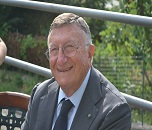Keynote Forum
Giulio Tarro
President of Foundation de Beaumont Bonelli for cancer research, Naples - Italy
Keynote: From sequence of tumor liberated protein (TLP) to potential targets for diagnosis and therapy
Time : 10:00-10:40AM

Biography:
Giulio Tarro graduated from Medicine School, Naples University (1962). Research Associate, Division of Virology and Cancer Research, Children’s Hospital (1965-1968), Assistant Professor of Research Pediatrics, College Medicine (1968-1969), Cincinnati University, Ohio. Oncological Virology Professor, Naples University (1972-1985). Chief Division Virology (1973-2003), Head Department Diagnostic Laboratories, (2003-2006). D. Cotugno Hospital for Infectious Diseases, Naples; Emeritus, 2006 -. Since 2007 Chairman Committee of Biotechnologies and VirusSphere, World Academy Biomedical Technologies, UNESCO, Adjunct Professor Department Biology, Temple University, College of Science and Technology, Philadelphia, recipient of the Sbarro Health Research Organization lifetime achievement award (2010). His researches have been concerned with the characterization of specific virus-induced tumour antigens, which were the "finger-prints" left behind in human cancer. Achievements include patents in field; discovery of Respiratory Syncytial Virus in infant deaths in Naples and of tumor liberated protein as a tumor associated antigen, 55 kilodalton protein overexpressed in lung tumors and other epithelial adenocarcinomas
Abstract:
A preliminary analysis of immunoprecipitation followed by Western Blotting (WB) shows corin and TLP precipitate at the same level (approximately 50 KDa) and are recognized by the same antibodies. In parallel the tests of immunoprecipitation were improved by the use of cell extracts derived from lung cancer cells A549 and NCI-H23 with the aim of obtaining a precipitate containing only the TLP. In fact the partial amino acid sequence of TLP shows a high homology with the sequence of human corin (only one amino acid is different) and is present in lung cancer under different isoforms. It is known that human corin is expressed mostly outside the cells and the protein extract derived from the extracellular medium and from the cells transfected with the plasmid, which overexpresses corin, shows several bands analysed on SDS-PAGE that are equivalent to the bands (about 50-100 KDa) observed in the WB analysed by anti-TLP. This protein band was identified as aldehyde dehydrogenase isoform 1A1 through mass spectrometry, revealing the molecular nature of at least one component of the previously described TLP complex. Next, we screened a cohort of 29 lung cancer patients (all histologies), 17 patients with non-neoplastic lung pathologies and 9 healthy donors for the presence of serum ALDH1A1 and global serum ALDH by enzyme-linked immunosorbent assay. This analysis indicated that the presence of ALDH was highly restricted to patients with lung cancer. Interestingly, the global ALDH test detected more lung cancer patients compared to the ALDH1A1-specific test, suggesting that other ALDH isoforms might add to the sensitivity of the assay. Our data suggest that ALDH levels may therefore be evaluated as part of a marker panel for lung cancer screening.Finally, the ability of the immune system to recognize a TAA, enables the development of a vaccine approach for preventive and therapeutic application and represents a main target of this field of research.










